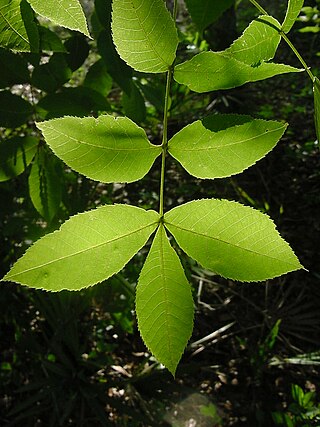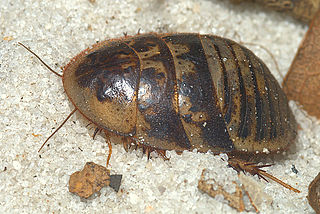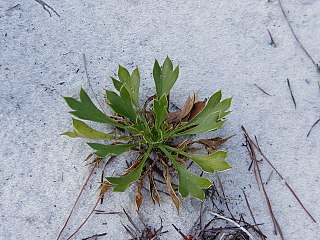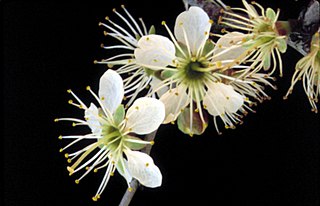
Pinus clausa is a species of pine endemic to the Southeastern United States. Its common names include sand pine, Florida spruce pine, and scrub pine.

The island scrub jay, also known as the island jay or Santa Cruz jay, is a bird in the genus, Aphelocoma, which is endemic to Santa Cruz Island off the coast of Southern California. Of the over 500 breeding bird species in the continental U.S. and Canada, it is the only insular endemic landbird species.

The Arboretum of the University of Central Florida is located on the main campus of the University of Central Florida in Orlando, Florida, United States. Covering 80 acres (320,000 m2), it contains more than 600 species of plants, including more than 100 bromeliads, in cultivated gardens.

The Lake Wales Ridge, sometimes referred to as the Mid-Florida Ridge, is a sand ridge running for about 100 miles (160 km) south to north in Central Florida. Clearly viewable from satellite, the white sands of the ridge are located in Highlands County and Polk County, and also extend north into Osceola, Orange, and Lake Counties. It is named for the city of Lake Wales, roughly at the midpoint of the ridge. The highest point of the ridge is Sugarloaf Mountain, which at 312 feet is also the highest natural point in peninsular Florida. Iron Mountain, the location of Bok Tower, marks another well known high point on the ridge, attaining an elevation of 295 ft (90 m). A northern unconnected extension of the Lake Wales Ridge exists in western Putnam County near the town of Grandin.

Carya floridana the scrub hickory, is a small tree native to the Southeast United States, where it is endemic to central Florida.

The Goethe State Forest is in the U.S. state of Florida. The 53,398-acre (216 km2) forest is located near the gulf coast, northwest of Dunnellon. Four trailheads are located on County Road 337. The main trail usage is equestrian, both riders and carts. Goethe is known for its population of red cockaded woodpeckers, a rare bird endemic to the longleaf pine forests of the southeastern coastal plain.

The Lake Wales Ridge State Forest is in the U.S. state of Florida. The 26,563-acre (107 km2) forest is located on the Lake Wales Ridge in Central Florida, within Polk County near Frostproof.

Florida scrub is a forest ecoregion found throughout Florida in the United States. It is found on coastal and inland sand ridges and is characterized by an evergreen xeromorphic plant community dominated by shrubs and dwarf oaks. Because the low-nutrient sandy soils do not retain moisture, the ecosystem is effectively an arid one. Wildfires infrequently occur in the Florida scrub. Most of the annual rainfall falls in summer.
Hogna ericeticola, known as the rosemary wolf spider, is a species of spider in the family Lycosidae. It is endemic to Florida scrub habitats in Putnam County, Florida, the United States.

The Lake Placid funnel wolf spider is a species of spider in the family Lycosidae. It is endemic to Florida scrub habitats in Highlands County, Florida, the United States.

Arenivaga floridensis is a species of sand cockroaches of the subfamily Corydiinae, in the family Corydiidae. It is a fossorial insect endemic to Florida scrub habitats in Highlands, Pinellas, and Polk counties in peninsular Florida.
The Caribbean bioregion is a biogeographic region that includes the islands of the Caribbean Sea and nearby Atlantic islands, which share a fauna, flora and mycobiota distinct from surrounding bioregions.

The Florida scrub jay is one of the species of scrub jay native to North America. It is the only species of bird endemic to the U.S. state of Florida and one of only 15 species endemic to the continental United States. Because of this, it is keenly sought by birders. It is known to have been present in Florida as a distinct species for at least 2 million years, and is possibly derived from the ancestors of Woodhouse's scrub jay.

Eryngium cuneifolium is a rare species of flowering plant in the carrot family known by the common names wedgeleaf eryngo, wedge-leaved button-snakeroot, and simply snakeroot. It is endemic to the state of Florida in the United States where it is known only from Highlands County. It is one of many rare species that can be found only on the Lake Wales Ridge, an area of high endemism. It was federally listed as an endangered species of the United States in 1987.

Hypericum cumulicola is a rare species of flowering plant in the family Hypericaceae known by the common name highlands scrub hypericum, or highlands scrub St. John's wort. It is endemic to Florida, where it is threatened by habitat loss and degradation. It is a federally listed endangered species of the United States.

Paronychia chartacea is a rare species of flowering plant in the family Caryophyllaceae known by the common names papery Whitlow-wort and paper nailwort. It is endemic to Florida in the United States. There are two subspecies of the plant; ssp. chartacea occurs in Central Florida, especially the Lake Wales Ridge, and ssp. minima is native to the Florida Panhandle. The two subspecies are geographically separated and do not occur together. Both are included on the federal Endangered Species List, on which the species is designated threatened.

Prunus geniculata is a rare species of plum known by the common name scrub plum. The species is endemic to Florida.
Lake Mary is a census-designated place and unincorporated area in Orange County, Florida, United States. The population was 1,575 at the 2010 census. It is part of the Orlando–Kissimmee Metropolitan Statistical Area.

Dorymyrmex elegans is a species of ant in the genus Dorymyrmex described by Trager in 1988, It is endemic to Florida scrubs on the Lake Wales Ridge in Florida.
Geolycosa xera, or Mccrone's burrowing wolf spider, is a species of wolf spider (Lycosidae) endemic to Florida in the United States.















